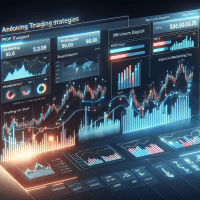Proven Prop Trading Risk Management: Advanced Strategies
In today’s volatile markets, mastering prop trading risk management is no longer a choice but a requirement. This comprehensive guide provides actionable strategies, detailed tool comparisons, and expert advice to empower both new and seasoned traders in the proprietary trading arena. From advanced backtesting techniques to a deep dive into compliance requirements such as MiFID II and ESMA guidelines, this post is your roadmap to optimizing risk management in a prop trading environment.
Figure 1: Screenshot of a backtesting report interface from TradingView illustrating key performance metrics.
Advanced Backtesting Strategies for Prop Trading
Reliable backtesting is the bedrock of successful prop trading. Advanced risk management requires integrating historical data with simulation techniques that account for real-world trading scenarios. In this section, we’ll cover:
- Automated Parameter Optimization: Leverage tools that finely adjust variables to simulate market conditions and optimize trading strategies.
- Walk-Forward Optimization: Unlike traditional backtesting, this method involves iterative testing which minimizes overfitting and ensures robust, out-of-sample performance.
- Out-of-Sample and Forward Testing: Crucial for validating models before committing real capital, ensuring that model predictions hold true under live conditions.
For instance, using Python’s Backtrader library, traders can script automated tests that not only run through historical data but also generate comprehensive performance reports, highlighting metrics such as Sharpe ratio, drawdown limits, and risk/reward ratios.
Pro Tip: Avoiding Common Pitfalls
Backtesting is fraught with potential errors including overfitting, survivorship bias, and look-ahead bias. Expert traders mitigate these by:
- Using multiple data sources to verify historical accuracy.
- Incorporating realistic trading costs like commissions and slippage.
- Implementing stringent out-of-sample tests to ensure true predictive power.
Comparing Top Automated Backtesting Tools for Prop Trading
Choosing the right tool is essential for a robust prop trading risk management program. Below is a detailed comparison of popular platforms:
| Tool | Backtesting Features | Data Quality | Integration Capabilities | Pricing | Use Case |
|---|---|---|---|---|---|
| TradingView | Vectorized analytics, auto parameter optimization, integrated charting | High-quality global market data, historical and real-time feeds | API access, broker integration, custom scripts | Subscription based, free trial available | Ideal for team collaboration in prop firms and detail-oriented retail traders |
| MetaTrader 5 | Event-driven backtesting, customizable test scenarios, commission/slippage simulation | Robust historical data, multi-asset class coverage | MT5 API, broker integrations, third-party plugins | Free demo; competitive spread pricing via brokers | Suitable for both institutional risk managers and individual traders |
| NinjaTrader | Optimized vectorized backtesting, scenario analysis, stress testing | Extensive historical data with market ticks | Integration with leading data providers and trading brokers | Free for simulation; license required for live trading | Best for advanced quant teams and detailed performance reporting |
| QuantConnect | Cloud-based backtesting, automated parameter sweeps, algorithm integration | Deep historical data across asset classes | API access, flexible algorithmic trading support | Free tier available; paid plans for extended features | Highly scalable for team-based backtesting in prop trading environments |
Industry Insight: Selecting the Right Tool
Different platforms offer strengths tailored to various aspects of prop trading. For instance, TradingView’s seamless integration and charting are excellent for tactical trade decisions, while QuantConnect excels in automated optimization and scalability for larger firms. Your choice should ultimately align with the specific strategies and compliance requirements of your trading environment.
Figure 2: An in-depth analysis report highlighting drawdown, Sharpe ratios, and other risk metrics from NinjaTrader.
Implementing Advanced Risk Management Techniques
Effective prop trading risk management is anchored in systematic implementation of risk control measures:
- Stop-Loss Orders: Automated implementations on platforms like MetaTrader 5 allow for precise execution even in volatile markets.
- Drawdown Limits: Advanced monitoring systems help traders set stringent drawdown thresholds to protect capital.
- Position Sizing: Tailored algorithms adjust exposure based on market conditions, enhancing risk/reward ratios.
For automation enthusiasts, a sample Python snippet using Backtrader illustrates automated stop-loss execution:
import backtrader as bt
class StopLossStrategy(bt.Strategy):
params = (('stop_loss', 0.95), )
def __init__(self):
self.dataclose = self.datas[0].close
def next(self):
if not self.position:
# Enter a trade if conditions met
if self.dataclose[0] > self.dataclose[-1]:
self.buy()
else:
# Set a stop-loss
if self.dataclose[0] < self.params.stop_loss * self.position.price:
self.close()
Case Studies: Real-World Success in Prop Trading
An anonymized prop trading firm recently overhauled its risk management framework using a combination of quantitative models and advanced backtesting tools. The firm encountered challenges such as overfitting and execution lag. By adopting walk-forward optimization and integrating real-time data from Interactive Brokers, they achieved:
- A 35% improvement in Sharpe ratio
- A reduction in maximum drawdown by 20%
- Faster iteration cycles, reducing model testing time by 40%
This blend of theoretical rigor and practical adjustment demonstrates how modern backtesting technologies directly impact prop trading efficacy.
Integrating Backtesting With Forward Testing
While backtesting provides historical context, it’s equally vital to execute forward testing through paper trading. This ensures the tested strategy performs well in live market conditions. Key performance metrics to monitor include:
- Real-time P&L analysis
- Parameter stability over different time frames
- Discrepancies between simulated and actual trading environments
Utilize platforms such as Trade Ideas and NinjaTrader for seamless transition from backtesting to live execution, ensuring continuous strategy refinement.
Regulatory Compliance and Prop Trading Risk Management
Compliance is critical in the prop trading sphere. Firms must navigate a complex regulatory landscape including MiFID II in Europe, ESMA regulations, and NFA rules in the US. These regulations demand robust risk management systems that ensure:
- Transparent pricing and trading practices
- Accurate reporting of risk measures
- Real-time monitoring to avoid regulatory breaches
Adhering to these frameworks not only prevents legal complications but also builds investor and client trust. Integration with compliance management systems and automated alert features further strengthens risk oversight.
Expert Guidance and Next Steps
The journey to mastering prop trading risk management is continuous. As you integrate these advanced strategies and tools, consider adopting the following improvements:
- Implement a detailed Risk Management Checklist to verify that every aspect of your trading strategy meets both performance and compliance benchmarks.
- Attend workshops or webinars on advanced backtesting techniques and regulatory updates.
- Utilize internal collaboration tools to share insights and updates on model performance across your trading desk.
For further reading, check our internal articles on prop trading strategies and advanced backtesting techniques.
Conclusion: With the right mix of advanced risk management strategies, automated tools, and compliance measures, prop trading professionals can significantly enhance their trading outcomes. Start by integrating these techniques and monitor your performance improvements closely. As of October 2023, staying ahead of market trends and regulatory changes remains imperative for sustainable success.
For a detailed risk management checklist complete with actionable items and evaluation metrics, download our exclusive resource now and join our upcoming webinar on cutting-edge prop trading strategies.







